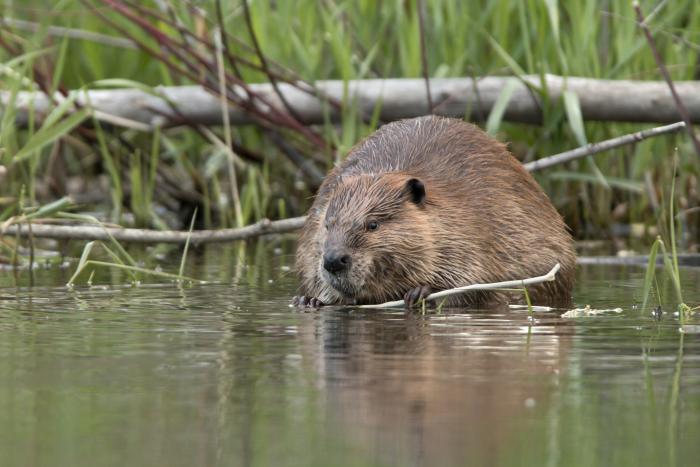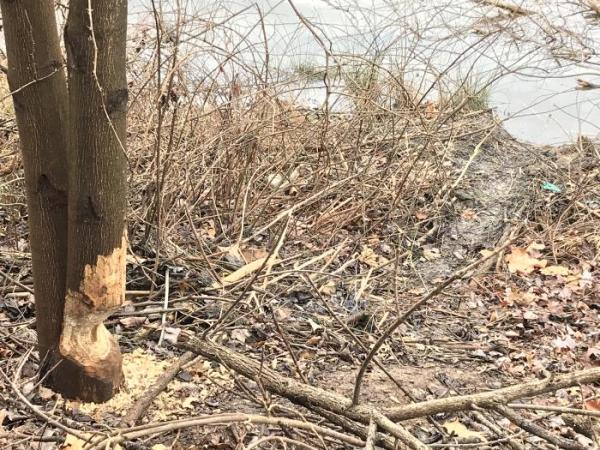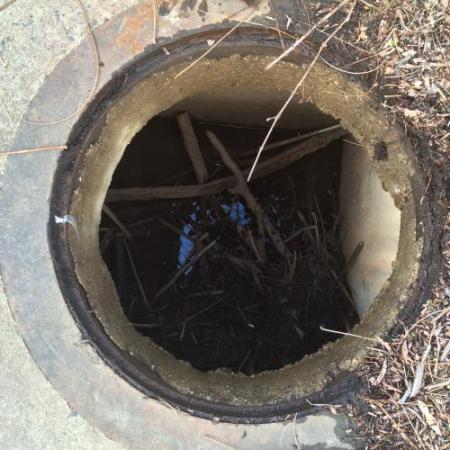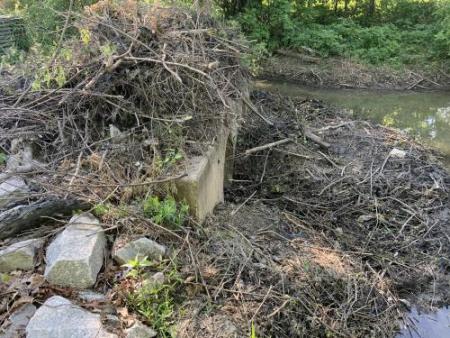Beavers are found in watersheds throughout Fairfax County and there has been a growing interest from landowners regarding how to manage and live with beavers. With both beaver and human populations increasing, it’s crucial to find ways to coexist. We encourage tolerance of beavers whenever possible when beaver activities are not impacting human uses or infrastructure. When problems do occur, most beaver conflicts related to property damage can be solved by implementing habitat modification measures that consider a beaver’s behavior. These measures provide effective and humane strategies to mitigate human-beaver conflicts in Fairfax County while fostering an environment of human-wildlife coexistence.
Tree Protection 
Cylindrical cages or tree guards are a practical and effective way to protect individual trees from beavers. Wire cylinders placed around the base of the tree trunks create a physical barrier that prevents beavers from gnawing on the trees.
Beavers favor trees like willow, alder, maple, birch, poplar, aspen, cottonwood, and cherry. Conifers are least preferred, but beavers may still girdle and kill these trees to encourage the growth of preferred food plants.
In general, beavers prefer to fell trees within 50 feet of water but can travel farther for preferred species. They normally start with trees closest to the water and work their way further out as resource supplies dwindle. Keep these points in mind as you determine which trees to prioritize for wrapping on your property.
To effectively protect trees from beaver damage, follow these key strategies:
- Prioritize wrapping healthy, high-value trees.
- Use galvanized welded wire fencing (14-gauge with 2x4 mesh) to encircle the trunk. This material is durable and found at hardware stores. Avoid flexible wire like chicken mesh, which is less robust.
- Fencing material that is 4 feet in height is recommended. Even in heavy snow, this should sufficiently exclude beavers.
- Leave a 6-inch to 12-inch gap between the tree trunk and the fencing to accommodate future tree growth without girdling (removal or damage to tree bark). Fasten the ends of the fence by bending the cut ends together or secure using hog rings or zip ties.
- Cut and flare out the fencing for low branches, roots, or sloped ground. Ensure the fence is securely anchored to the ground with landscape pins or stakes to prevent beavers from digging or pushing the fence up to gnaw underneath.
- Wrap trees before or immediately after the first signs of chewing. Once a tree is fully girdled, it will die.
- The wire cylinder tree guard is low-maintenance and should remain effective for many years. Regular checks may be needed to ensure no damage or gaps have developed. In cold climates, ensure the fence height accommodates snow levels.
- For clusters of shrubs or grove of trees, encircle the priority area with single, larger diameter fence instead of individual tree guards, as needed.
By implementing these protective measures, you can safeguard valuable trees while accommodating beaver activity in the surrounding area.
Tree wrapping is not the only tree protection method available. Painting tree trunks with a mixture of coarse mason’s sand or playground sand (30–70 mil) and exterior latex paint may help to deter beavers from gnawing on trees. The ratio is twenty ounces of sand to one gallon of paint. Stir often and paint tree trunks from the bottom of the tree to about 3-4 feet high. The paint can be clear or color-coded to match the trees. This method has shown some success but is generally less reliable than the tree-wrapping technique and is ineffective for saplings.
Flood Control
Beavers instinctively build dams to raise water levels for protection from predators and safe access to food sources, but sometimes these dams can cause flooding issues for people. Flooding by beavers generally occurs where beavers dam streams or plug culverts which can impact the integrity of roads and neighboring property.
Flow Devices and Exclusion Fencing
Habitat modification techniques, including the installation of flow devices and exclusion fencing, used alone or in combination, provide effective and economical solutions to control water levels to prevent flooding and protect human infrastructure.
Flow devices, called pond levelers, are used to alleviate flooding issues and control the water level of a beaver pond or stream by creating a “notch” in the dam which allows water to continue to flow, while allowing beavers to remain onsite. Flow device designs prevent beavers from detecting the flow of water into the pipe, so beavers do not try to block it. Pond Levelers consist of a long, corrugated pipe that is installed through a notch in the beaver dam to allow water to flow through the dam at a lower level. A cage is placed around the pipe inlet to prevent beavers from clogging the pipe with debris. This structure allows water to continue to flow through a dam without blockage from the beavers and allows beavers to coexist onsite.
Fence designs are often used to protect road culverts and allow beavers to continue to dam along the edges of the fence while maintaining water flow. Culvert protective fences are trapezoidal-shaped fences that are placed in front of, or surrounding, a culvert-like area that beavers want to dam. The fences extend outward to create a perimeter around the culvert that prevents the opening from being dammed by beavers.
There are numerous designs and names for flow devices and fencing solutions, such as beaver baffles, beaver deceivers, Clemson beaver pond levelers, diversion dams, keystone fence, starter dams, and fence and pipe installations. The type of device that will be most effective will depend on the site conditions, available resources, and management objectives specific to each property. It is recommended that property owners consult a trained professional who specializes in beaver management and installation of flow devices to discuss potential mitigation options to determine the most appropriate design for their property and to ensure regulatory compliance if permitting is required.
Dam Breaching/Removal
Breaching or removing dams may provide immediate relief to flooding and dangers to property or infrastructure but should be considered a short-term solution. Beavers are stimulated to build their dams by the sound or feel of running water. In most cases, if a dam is breached or removed, beavers will begin immediately rebuilding and the dam may be reconstructed within 24 to 48 hours. Beavers cut new material to rebuild dams, so repeated dam removal results in more property damage from vegetation being removed by beavers along the riparian buffer. Dam removal can also result in sediment behind the dam moving downstream. Before a dam is breached or removed, an evaluation should be conducted to ensure that released flows do not endanger other structures or property. Prior to altering a beaver dam, the property owner should also determine if permits are required from county, state, and/or federal authorities. While this approach may be useful to alleviate flooding in some situations, the use of flow devices and exclusion fencing is recommended for a long-term, effective approach to reduce flooding and property damage associated with beaver damming activities.
 Beavers are an established part of the native wildlife community in Fairfax County. They inhabit wetland and riparian areas, including rivers, streams, marshes, lakes and ponds throughout Fairfax County. Often called nature's "engineers”, beavers play a crucial role in maintaining healthy ecosystems by creating and shaping wetland environments through their actions of felling trees and building dam structures.
Beavers are an established part of the native wildlife community in Fairfax County. They inhabit wetland and riparian areas, including rivers, streams, marshes, lakes and ponds throughout Fairfax County. Often called nature's "engineers”, beavers play a crucial role in maintaining healthy ecosystems by creating and shaping wetland environments through their actions of felling trees and building dam structures.


.jpg)


